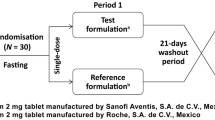Abstract
We evaluated the tolerance and effectiveness of the oral Clonidine test for GH in 75 children, 84% with hyposomia and 16% with other diseases. The test was well tolerated, since 97% of the examined children had no side effects with the exception of occasional drowsiness, pallor and myosis of short duration. Two of the children at the end of the test, had more severe symptoms 30 min after (deep asthenia, pallor and a further small blood pressure drop) which however, resolved after 4–6 h. No correlation was observed between the clinical picture and the drops in blood pressure and/or plasma cortisol in the children examined. We confirm the effectiveness of the Clonidine test in the release of GH since in our study we observed no negative false subnormal responses.
Similar content being viewed by others
References
Eden S., Eriksson E., Martin S.B. Evidence for a growth hormone releasing factor mediating alpha-adrenergic influence on growth hormone secretion in the rat. Neuroendocrinology 33: 24, 1981.
Miki N., Onu M., Shizume K. Evidence that opiatergic and alpha-adrenergic mechanisms stimulate rat growth hormone release via growth hormone-releasing factor. Endocrinoglogy 114: 1950, 1984.
Anden N.E., Grabowska M., Strombom U. Different alpha-adrenoreceptors in the central nervous system mediating biochemical and functional effects of clonidine and receptor blocking agents. Naunyn Schmiedebergs Arch. Pharmacol. 292: 43, 1976.
Gil-Ad I., Topper E., Laron Z. Oral Clonidine as a growth hormone stimulation test. Lancet 2: 278, 1979.
Greulich W.W., Pyle S.I. Atlas of skeletal development of the hand and wrist, ed. 2. Stanford University Press, Stanford, 1955.
Tanner J.M., Whitethouse R.H. Clinical longitudinal standards for height, weight, height velocity, weight velocity and stages at puberty. Arch. Dis. Child. 51: 170, 1976.
Frase N.C., Seth J., Brown N.S. Clonidine is a better test for growth hormone deficiency than insulin hypoglycaemia. Arch. Dis. Child. 58: 355, 1982.
The health services human growth hormone Committee. Comparison of the intravenous insulin and oral clonidine tolerance tests for growth hormone secretion. Arch. Dis. Child 56: 852, 1981.
Lanes R., Hurtado E. Oral clonidine- an effective growth hormone-releasing agent in prepubertal subjects. J. Pediatr. 100: 710, 1982.
Salti R., Galluzzi F., Beccherucci P., Seminara S., Calzolari C., Innocenti S., La Cauza C. Oral Clonidine: an effective provocative test of growth hormone release. Helv. Paediatr. Acta 36: 527, 1981.
Lanes R., Becker B., Fort P., Lifshitz F. Low dose oral Clonidine. Am. J. Dis. Child. 139: 87, 1985.
Artman M., Boerth R.C. Clonidine poisoning. Am. J. Dis. Child. 137: 171, 1983.
Author information
Authors and Affiliations
Rights and permissions
About this article
Cite this article
De Angelis, R., Pellini, C., Petecca, C. et al. Tolerance of the oral Clonidine test in 75 pediatric patients. J Endocrinol Invest 11, 379–382 (1988). https://doi.org/10.1007/BF03349059
Received:
Accepted:
Published:
Issue Date:
DOI: https://doi.org/10.1007/BF03349059




